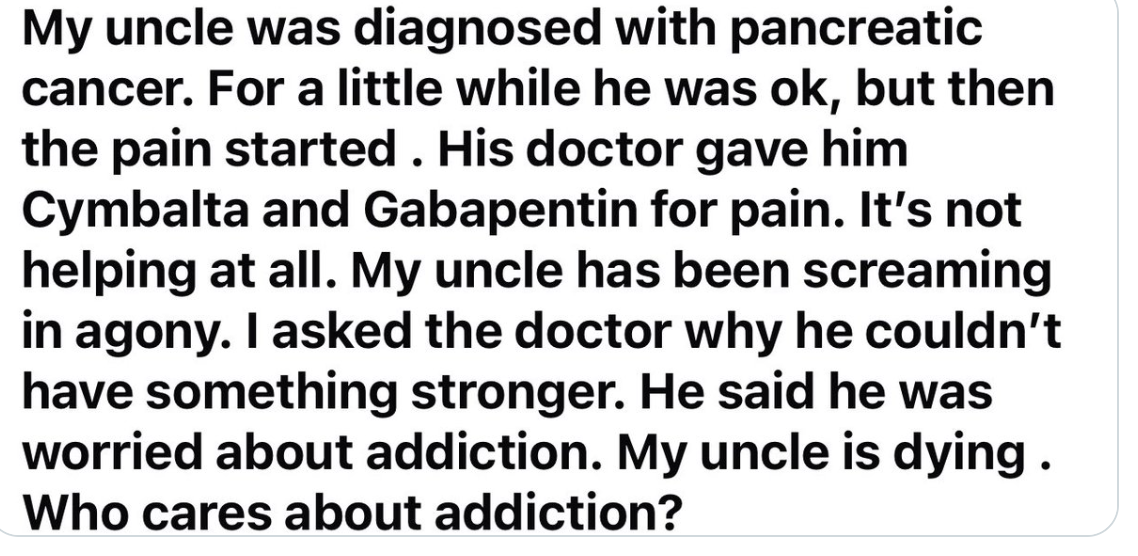Note to Readers: Depending upon your perspective, this article may come across as flippant, offensive, possibly reckless, and almost certainly disturbing. After all, aren't there enough suicides plaguing us as a society? In a normal world where people could expect to receive appropriate medical care regardless of their conditions, the answer would be yes. But we no longer live in that world. Opioid-phobia has made that assumption a thing of the past. For tens of millions of Americans who live in pain appropriate medical care is also a thing of the past. Actions by certain individuals, NGOs, and government agencies have seemingly removed the Eighth Amendment–cruel and unusual punishment– from our constitution. For those affected by cruel new policies suicide is no longer reckless; it is a reasonable alternative to life.
###
Few Western countries are more restrictive of a person’s right to choose their own fate—whether to live or die—than the United States. Only ten states have laws permitting physician-assisted suicide (PAS) and all ten have requirements–some stricter than others–for allowing people to end their lives with the assistance of a doctor. For example, all ten states require that the person have a terminal disease with less than 6 months to live.
(Oddly, 27 states still have the death penalty–6 of them have temporary moratoriums–and almost without exception, these are the same states that do not permit PAS. Perhaps there is some strange logic here that I fail to grasp.)
There is no “US” in “compassion”
Similarly, few Western countries are as stringent as the US in limiting the use of opioid medications for pain. Over the past decade, both opioid pain medications and the doctors to prescribe them have become scarce leaving pain patients–even those who had been successfully treated with opioids for years or even decades–in an impossible situation. Tens of millions of these unfortunate souls “live” in a state of perpetual misery, some bed-bound by ceaseless severe pain. Many of them wish to end their suffering by committing suicide; hardly a month goes by when I don’t get asked to help them with this, something I cannot legally do.
And, since most pain patients do not have less than 6 months to live they do not qualify for PAS no matter how much they suffer.
Europe vs. the US
So, it is not surprising that a "high-tech" device called the Sarco, also known as the "suicide pod," which requires neither physicians nor drugs, was invented there. The device, which operates by nitrogen hypoxia (more on this below) was designed to provide a peaceful and painless death. According to the organization Exit International, it will be available for use this year.
Death by nitrogen hypoxia
As I wrote in a 2017 article on capital punishment, of all the execution methods now used (and mostly botched) by prisons, nitrogen hypoxia, when used properly, is probably the most humane (2). The same applies to suicide. Hypoxia, a condition caused by an inadequate supply of oxygen, is very different from what most people think of suffocation. The horrific gasping when you try to hold your breath is a reflex caused by the buildup of carbon dioxide in the blood, not the lack of oxygen.
However, when people breathe inert, harmless gases, usually helium (3) or nitrogen, they do not experience the same feeling of suffocation as someone being choked. Instead, they keep breathing normally until they lose consciousness, and death occurs shortly thereafter—but only when it's done right.
Rapid replacement of oxygen is essential
The efficacy of using inert gases (aka, the "bag method") for suicide, which is the second most common method after firearms, became popular in the 2000s. Its success depends upon the time until unconsciousness, the less the better. This time depends on how quickly oxygen levels are reduced. Air consists of 21% oxygen and 78% nitrogen. Typically, 10% oxygen is the level at which people black out and die. Between these two concentrations, people can experience awful symptoms (shortness of breath, confusion, panic).
The Sarco device
According to Dr. Philip Nitschke, a co-inventor, (also called "Dr. Death"), the Sarco capsule reduces the oxygen content within the device from 21% to 0.05% in 30 seconds. No plastic bag can match this.
"Within two breaths of air of that low level of oxygen, they will start to feel disorientated, uncoordinated, and slightly euphoric before losing consciousness."
Dr. Philip Nitschke , July 17, 2024
It wasn't meant to be this way. Source: Twitter.
Perhaps the Sarco isn't such a radical idea after all.
NOTES:
(1) PAS and euthanasia differ in that the latter involves active participation by another individual. Euthanasia is even more controversial than PAS.
(2) If our prison system can get something wrong it probably will: "On January 25, the state of Alabama executed Kenneth Smith using nitrogen hypoxia, subjecting him to inhale pure nitrogen through a mask until he suffocated. Despite state claims that it would be a painless death, witnesses reported Mr. Smith shook, convulsed, writhed, and gasped for minutes until he was pronounced dead at least 22 minutes after the execution began, though just how long it took is unknown since Alabama closed the execution curtain before the official time of death."
Source: American Civil Liberties Union
(3) In the early 2000s the "bag method" became popular with people trying to commit suicide. The inert gas of choice was helium, which could easily be purchased from party supply companies. When these companies learned of this they started adding air or oxygen to the canisters.





